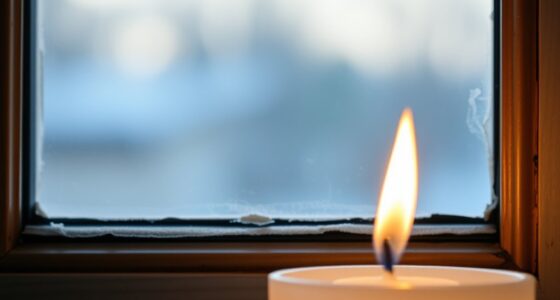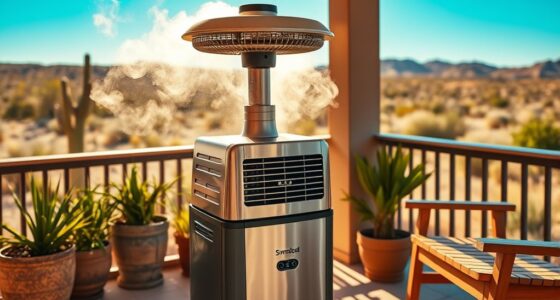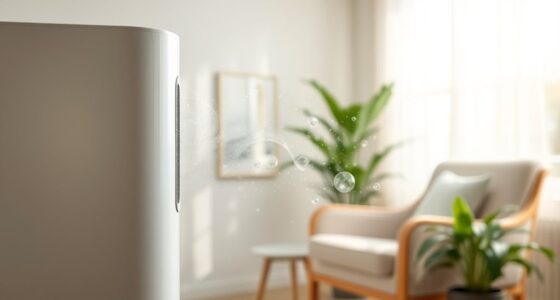Place your space heater on a flat, stable surface away from curtains, furniture, and bedding, keeping at least 3 feet clearance around it. Keep it away from high-traffic areas, wet or humid spots, and anything flammable. Never cover it or place it near power cords in walkways. Position it near a reachable outlet but avoid placing it where children or pets can knock it over. For safety tips and proper setup, continue exploring the details.
Key Takeaways
- Place the heater on a flat, stable, fire-safe surface at least 3 feet away from flammable materials.
- Keep it near accessible outlets, avoiding cords in walkways, and never cover the heater during use.
- Maintain at least 3 feet of clearance around the heater for proper heat circulation.
- Avoid high-traffic areas, moist environments, and locations accessible to children or pets.
- Regularly inspect cords and ensure the heater is positioned on level surfaces to prevent tipping or fire hazards.
Choosing the Right Spot Away From Flammable Materials

To prevent fires and guarantee safe operation, always choose a spot for your space heater that’s away from flammable materials. Keep it at least three feet from curtains, bedding, paper, and furniture. Pay attention to cord safety by ensuring the power cord isn’t stretched across walkways or under rugs, where it could overheat or get damaged. Also, consider pet hazards—pets might knock over the heater or chew on cords, risking burns or electrical shock. Place the heater on a flat, stable surface, away from high-traffic areas, to prevent accidental tipping. Regularly inspect cords for fraying or damage, replacing them immediately if needed. By following these guidelines, you’ll reduce fire risk and create a safer environment for everyone, including your pets. Creating a clutter-free space not only enhances safety but also promotes a calm and organized living environment.
Keeping Space Heaters on a Level, Stable Surface
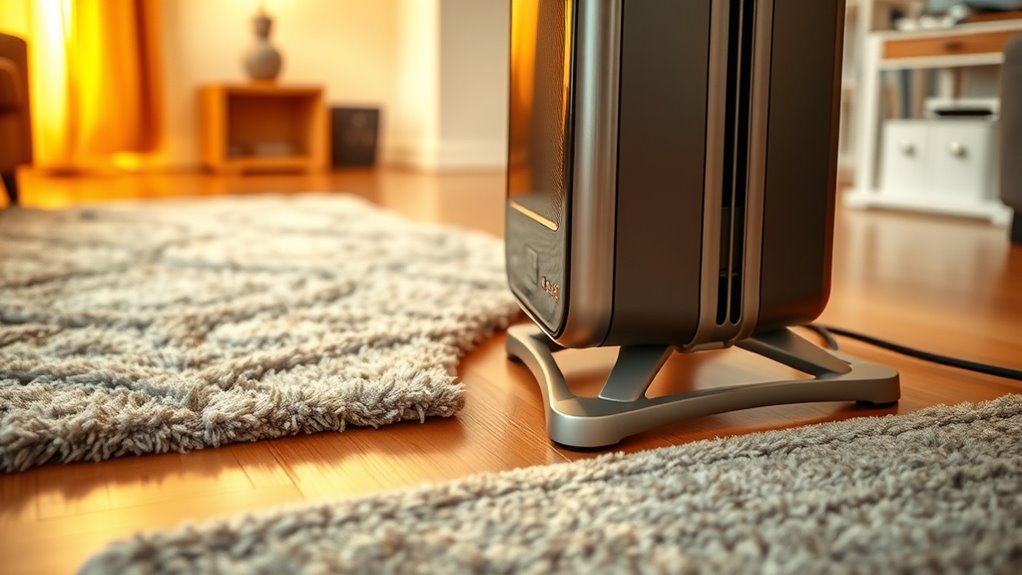
To keep your space heater safe, place it on a flat, stable surface. Avoid setting it on unstable furniture or uneven floors that could tip or shift. Use sturdy supports to guarantee it stays secure and upright at all times. Ensuring proper stability can also prevent accidents caused by tipping or accidental contact.
Choose a Flat Surface
Ensuring your space heater sits on a flat, stable surface is essential for safe operation. A level surface prevents tipping and reduces fire risks. For portable placement, choose a sturdy tabletop or flat floor area that can support the heater’s weight securely. Avoid uneven or soft surfaces that might cause instability. Consider the following options:
| Suitable Surface | Unsuitable Surface |
|---|---|
| Solid tabletop or shelf | Wobbly furniture or rugs |
| Flat, even flooring | Uneven or soft carpets |
| Stable countertop | Unsecured surfaces |
| Level surface with no clutter | Sloped or cluttered areas |
Prioritize surface stability to keep your heater secure and functioning safely. Additionally, always ensure the surface is fire-safe and free of combustible materials.
Avoid Unstable Furniture
Placing your space heater on unstable furniture can lead to accidents and fire hazards. Unstable furniture or uneven surfaces increase the risk of the heater tipping over, which can cause fires or burns. Avoid placing your heater on chairs, sofas, or cluttered tables, as these are often unstable and can shift unexpectedly. Instead, find a flat, sturdy surface that can support the weight of the heater securely. If the surface is uneven, use a leveling pad or a piece of plywood to create a stable base. Ensuring your space heater sits on a level, stable surface minimizes the risk of it falling or tipping over, keeping you and your home safe from potential hazards. Additionally, choosing a properly designed surface specifically meant for heavy appliances can further enhance stability and safety.
Use Sturdy Supports
Using sturdy supports is essential for keeping your space heater safe and stable. Always place it on a secure mounting or heavy supports that won’t shift or tip over easily. Avoid soft or uneven surfaces like rugs or flimsy furniture, which can cause the heater to fall or become unstable. Make sure the surface is level and can bear the weight of the heater comfortably. If your heater comes with a mounting bracket or stand, use it to ensure maximum stability. Proper support prevents accidental falls, fires, and injuries. Check regularly to confirm the supports remain secure. Remember, a well-supported heater stays safer, operates more efficiently, and reduces the risk of accidents in your home. Understanding fandom’s past, present, and future can help industry professionals develop safer, more user-friendly heating solutions.
Avoiding High-Traffic and Unsupervised Areas

Avoiding high-traffic and unsupervised areas is essential to prevent accidents when using a space heater. Place the heater in a location where children safety isn’t at risk, such as away from busy hallways or play areas. Keep pets protected by ensuring they can’t knock over or get too close to the heater, which could cause burns or fires. Never leave the heater unattended in a spot where kids or pets can accidentally come into contact with it. Choosing a quiet, low-traffic corner minimizes the chance of tripping over cords or bumping into the unit. By being mindful of where you position your space heater, you promote a safer environment for everyone and reduce the risk of unintended injuries or hazards. Regularly assessing your space for clutter buildup helps maintain a clear area around the heater, further reducing safety risks.
Maintaining Proper Clearance Around the Heater

To prevent fires and accidents, you need to maintain proper clearance around your space heater. Keep cords away from walkways and heat sources to avoid tripping hazards or electrical fires. Ensure there’s enough space around the heater so heat can circulate freely; this helps it operate efficiently and prevents overheating. Maintain at least three feet of clearance on all sides, especially away from furniture, curtains, or bedding. Avoid overcrowding the area with clutter, which can block airflow and increase fire risk. Regularly check the cord and plug for damage, and never run the cord under carpets or rugs. Proper clearance not only reduces hazards but also guarantees your heater functions safely and effectively. Additionally, understanding building codes and safety regulations can help ensure your heater installation complies with local standards.
Steering Clear of Wet or Humid Locations
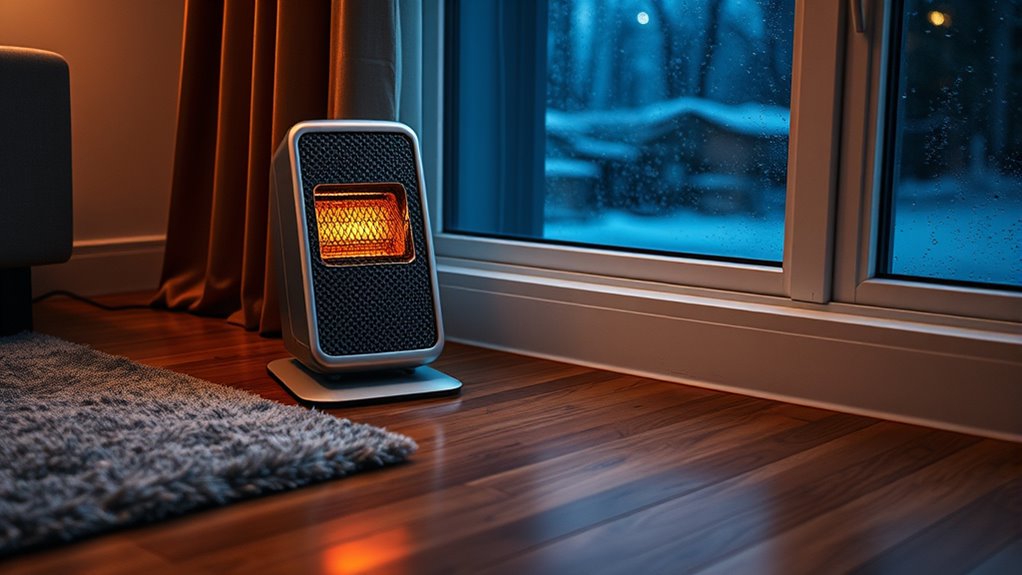
Placing your space heater in wet or humid areas considerably increases the risk of electrical shock and damage. Humid environments and moisture exposure can cause electrical components to malfunction or short circuit, posing safety hazards. Avoid placing your heater in bathrooms, laundry rooms, basements, or near open windows where humidity levels are high. Moisture can seep into the device, leading to corrosion or electrical failures. Even small amounts of moisture can compromise the safety and efficiency of your heater. Proper workspace organization can help you identify safe spots away from moisture sources. Always choose a dry, well-ventilated spot with low humidity. Keeping your heater away from damp areas not only protects the device but also reduces the risk of fire, shocks, and costly repairs. Prioritize dry, safe locations for *ideal* safety and performance.
Keeping Heaters Away From Furniture and Curtains
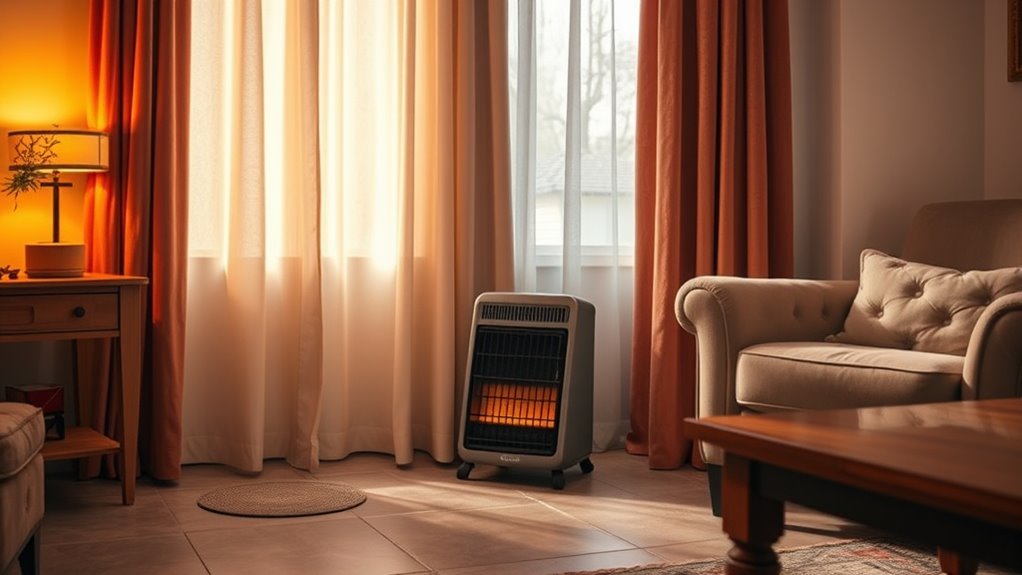
Since space heaters generate heat and can become hot to the touch, keeping them away from furniture and curtains is essential for safety. Placing your heater near fire-resistant curtains and non-flammable furniture reduces fire risk. To visualize safe placement:
| Item | Distance from heater | Material Type |
|---|---|---|
| Fire-resistant curtains | At least 3 feet away | Fire-resistant fabric |
| Non-flammable furniture | At least 3 feet away | Non-flammable material |
| Flammable curtains | Keep well clear | Standard fabric |
| Upholstered sofas | Maintain distance | Flammable fabric |
Ensure there’s a clear space around the heater, and avoid placing it near anything that could catch fire. Proper placement minimizes hazards and keeps your home safe. Understanding safety standards can further help in choosing the right placement.
Safe Placement Near Power Outlets and Cords

Ensuring your space heater is properly positioned near power outlets and cords is essential for safety. You should always choose outlets that are easily accessible and avoid overloading them, which can lead to electrical issues. Proper outlet placement helps prevent the need for long, tangled cords that pose tripping hazards or damage. Keep cords out of walkways and away from high-traffic areas to reduce the risk of accidental pulling or disconnection. When plugging in your heater, ensure the cord is not stretched tight or pinched, which can cause damage or fire hazards. Practice good cord safety by inspecting cords regularly for frays or damage. Additionally, choosing a safe location for heating appliances can significantly reduce fire risks and improve overall safety. Remember, a well-placed heater with secure, safe cord connections minimizes risks and keeps your space warm safely.
What to Avoid When Positioning Your Space Heater
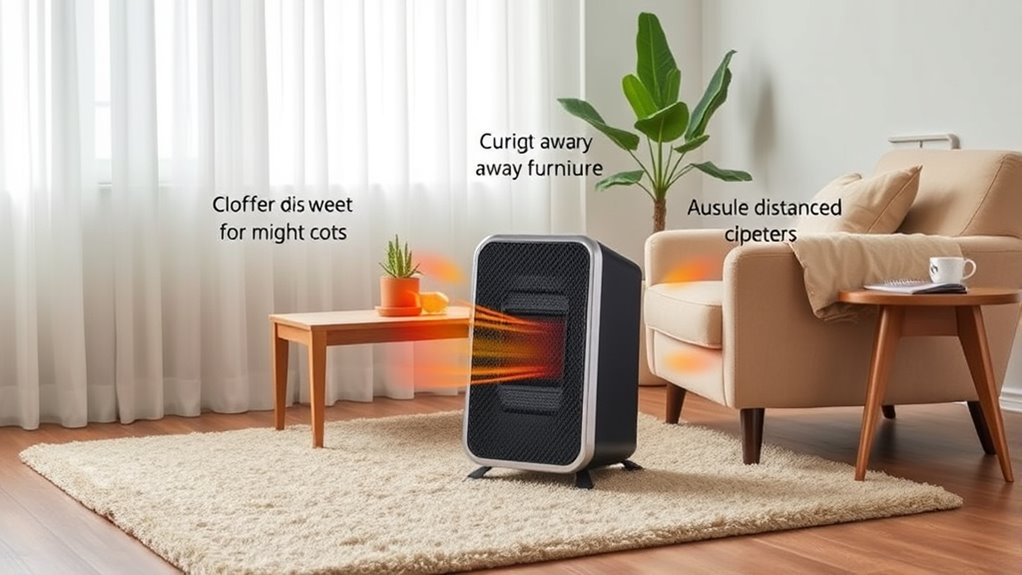
When positioning your space heater, you should keep it away from anything flammable like curtains or paper. Avoid placing it in high-traffic areas where it could be knocked over or cause accidents. Never cover the heater, as this can lead to overheating and potential fires. Ensuring proper placement can help prevent trust issues, which are often caused by neglect or oversight.
Keep Away From Flammables
To prevent fire hazards, you should keep your space heater away from flammable materials like curtains, paper, furniture, and clothing. These items can ignite easily if placed too close. Make sure you maintain at least these precautions:
- Keep combustible items a minimum of 3 feet away from the heater.
- Position your fire extinguisher nearby, but not in the path of heat.
- Adjust the heater thermostat settings to avoid overheating.
- Never place the heater where it could tip over onto flammable objects.
- Regular maintenance and inspection of the heater and surrounding area help prevent fire risks and ensure safe operation.
Avoid High-Traffic Areas
Placing your space heater in a high-traffic area can create safety risks and increase the chance of accidents. Busy spots with cluttered corners or outdoor settings attract movement and objects that can accidentally knock over or come into contact with the heater. Avoid areas where people frequently pass through, as this raises the risk of tripping or knocking it over. Consider the table below for examples of places to avoid:
| High-Traffic Areas | Cluttered Corners | Outdoor Settings |
|---|---|---|
| Hallways | Behind furniture | Patios or decks |
| Near doorways | Corners with toys | Garden sheds |
| Main walkways | Storage areas | Uncovered porches |
| Living room entrances | Cluttered shelves | Unprotected outdoor spaces |
Additionally, ensuring proper heater placement can help optimize safety and efficiency.
Don’t Cover the Heater
Avoid covering your space heater, as it can block airflow and cause it to overheat. Covering heaters or placing objects on top of them prevents proper ventilation, increasing fire risk. To guarantee safety, keep these in mind:
- Never place blankets, clothing, or paper directly on or over the heater.
- Avoid stacking furniture or other items near the heater’s vents.
- Keep curtains, drapes, or bedding away from the heater’s surface.
- Do not use covers or shields that restrict airflow around the device.
Blocking vents traps heat, which can lead to overheating or malfunction. Proper placement and unobstructed vents are essential for safe operation. Remember, covering heaters compromises their safety features and increases the risk of fire or damage.
Frequently Asked Questions
How Often Should I Inspect My Space Heater for Safety Issues?
You should perform a safety inspection of your space heater at least once a month. Follow a maintenance checklist that includes checking for frayed cords, loose wiring, and any signs of wear or damage. Regular inspections help you catch potential hazards early, ensuring safe operation. If you notice any issues, stop using the heater immediately and get it repaired or replaced before further use.
Can I Use Extension Cords With My Space Heater Safely?
Using extension cords with your space heater is a big no-no—think of it as risking a mini fireworks show in your home! Extension cords safety is essential, but they can’t handle the power needed for heaters. Always follow heater placement tips: plug directly into a wall outlet, and keep cords out of high-traffic areas. This keeps your space safe and your heater working efficiently without turning your home into a hazard zone.
What Are the Signs of a Malfunctioning Space Heater?
If your space heater shows signs of malfunction, you’ll notice flickering or dimming lights, strange smells, or unusual noises like buzzing or clicking. It might also turn off unexpectedly or fail to warm the room effectively. These malfunction signs indicate heater failure and mean you should unplug it immediately. Continuing to use a faulty heater can be dangerous, so always inspect for issues and get repairs or replacements when needed.
Is It Safe to Leave a Space Heater Unattended Overnight?
You shouldn’t leave a space heater unattended overnight because it increases fire risk. Make certain a fire extinguisher is nearby and keep the heater away from flammable objects. Set the thermostat to a safe, consistent temperature to prevent overheating. Always turn the heater off when sleeping or leaving the house. Doing so minimizes potential hazards and keeps your home safer during the night.
How Do I Properly Store My Space Heater When Not in Use?
To properly store your space heater, first unplug it and let it cool completely. Clean any dust or debris, then find a dry, cool storage spot. Use storage organization solutions like a sturdy box or a storage bin to keep it protected. During seasonal maintenance, check for damage and make sure it’s in good condition before storing. This keeps your heater safe, functional, and ready for next winter.
Conclusion
By following these simple tips, you’ll turn your space heater into a safe, reliable warmth source and avoid turning your home into a fiery inferno. Remember, a little caution goes a long way—think of it as guarding your home from disaster like a knight protecting a treasure. Stay vigilant, keep safety at the forefront, and enjoy cozy comfort without risking your castle. Your safety is worth more than all the treasure in the world!


